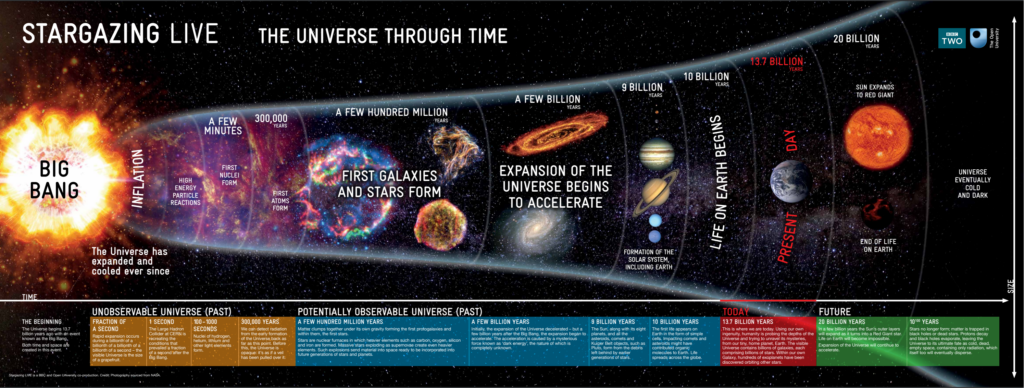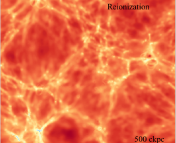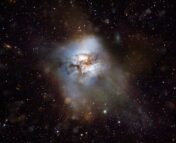The Undergraduate Research series is where we feature the research that you’re doing. If you are an undergraduate that took part in an REU or similar astro research project and would like to share this on Astrobites, please check out our submission page for more details. We would also love to hear about your more general research experience!

Lauren Elicker
University of Cincinnati
Hi, my name is Lauren. I recently graduated from the University of Cincinnati with bachelor’s degrees in physics and astrophysics. I spent the summer of 2022 working on this research at the Cosmic Dawn Center in Copenhagen with Dr. Kasper Heintz as part of the DAWN-IRES Scholars Program.
All was quiet in the cosmos until the first stars and galaxies formed billions of years ago, marking the start of the reionization of the universe. The Epoch of Reionization was a period when the hydrogen that composed most of the universe became ionized again, after 200 million years of hydrogen existing as neutral atoms. Astronomers are unsure of when and how exactly the universe became reionized, which is one of the biggest questions in modern astronomy. Reionization is driven by a special group of photons called Lyman-continuum (LyC) whose energy is tuned just right to knock a hydrogen’s electron out of orbit. The big question revolves around where these LyC photons came from. Many astronomers suspect early galaxies as being the hosts of LyC that reionized the universe.

Many galaxies existing during Reionization have detectable Lyman-Alpha (Lyɑ) emission, radiation that’s released when hydrogen atoms transition from their first excited state to their ground state. The Lyɑ transition occurs in many galaxies, yet we cannot always detect this emission. When a Lyɑ photon is released, it can be scattered (repeatedly absorbed and emitted) by neutral hydrogen (HI) atoms. If a photon scatters to the edge of a galaxy, it may escape and be detected as Lyɑ emission.
If, however, no Lyɑ photons are able to escape a galaxy, that indicates that no LyC photons can escape either, so that galaxy would not have contributed to reionizing the universe. This is because Lyɑ photons are emitted with a tiny range of wavelengths, making them easy to absorb, emit, and potentially escape the galaxy, while LyC photons have a wide range of wavelengths, making repeated scattering and escape more difficult. Recent work suggests only galaxies emitting Lyɑ can have strong LyC emission. Therefore, we are interested in Reionization Epoch galaxies that have detectable Lyɑ emission.
Since the galaxies that formed during Reionization contain high amounts of HI, the question remains: how does high HI gas content impact Lyɑ’s ability to escape from those galaxies?
Could something as basic as neutral hydrogen have prevented some galaxies from contributing to the reionization of the universe?
To address this question, we studied a sample of galaxies from multiple data sets that are observed near the end of Reionization and show Lyɑ and [CII] emission ([CII] emission comes from once-ionized carbon, carbon that has absorbed the right amount of energy for one electron to escape). HI is difficult to measure directly in older galaxies since its 21-cm emission is faint and infrequent; therefore, we used [CII] as a proxy for HI.
We essentially compared the redshifts of Lyɑ and [CII] emission in each galaxy. Redshift refers to the wavelength measurement an observer makes of emitted photons compared to their true wavelength. We’re observing Lyɑ and [CII] in galaxies that are traveling away from us; as they move away, it takes an increasing amount of time for their photons to reach us, thus increasing the observed wavelength of those photons. Since elements emit photons at distinct wavelengths, we compare their known wavelength with their observed one to calculate how fast their host galaxy is traveling away from us.
The redshifts determined using Lyɑ and [CII] from a galaxy are not always the same. This velocity difference is known as a “velocity offset.” We compared the Lyɑ and [CII] velocity offsets with our HI mass estimates to see how HI impacts Lyɑ escape, as Lyɑ velocity offset is anticorrelated with Lyɑ escape fraction (the fraction of produced Lyɑ photons that escape a galaxy). For our sample of Epoch of Reionization galaxies, we see tentative evidence of a positive relationship between the Lyɑ velocity offset and HI gas mass. The same analysis with a sample of galaxies (from the ALPINE survey) from the cosmological period right after Reionization does not show the same trend.
![A plot showing Lyman-Alpha and [CII] velocity offsets (on the vertical axis) vs. the HI gas mass (on the horizontal axis) for a sample of Reionization Epoch galaxies. A red trendline connects a few data points showing a slightly positive correlation between the HI gas mass and the Lyman-Alpha velocity offset.](https://astrobites.org/wp-content/uploads/2023/10/offsetvsmass.jpeg)
These trends lead us to believe that Lyɑ escape in galaxies during the Epoch of Reionization is impacted by a galaxy’s global HI gas content rather than local HI regions (such as star-forming regions). Our findings suggest that more abundant HI gas results in a larger Lyɑ velocity offset, meaning it is more difficult for Lyɑ to escape; An increasing amount of HI hinders the escape of Lyɑ, therefore also hindering the escape of LyC ionizing photons, which tells us we should look at the overall HI content of galaxies to learn more about what reionized the universe. A major problem that scientists face when attempting to study Reionization is the lack of observations of galaxies from this time period since they require high resolution over huge distances. JWST will be able to take more higher-quality observations of these old galaxies, giving us a larger and more detailed data set with which to study the Epoch of Reionization. Here’s to hoping JWST will help us finally piece together the puzzle of cosmic reionization.
Astrobite edited by: Ryan Golant
Featured image credit: The Kavli Institute for Astronomy and Astrophysics at Peking University




